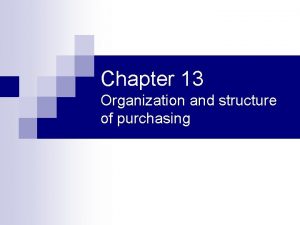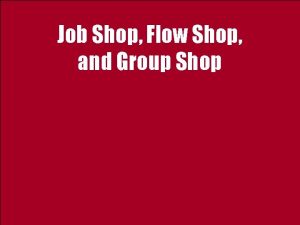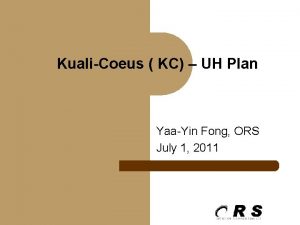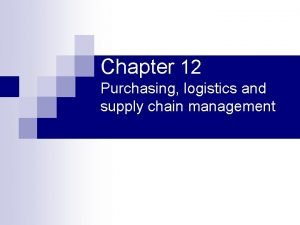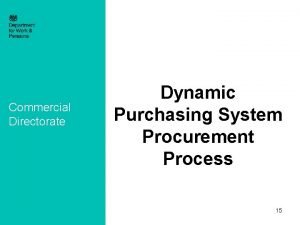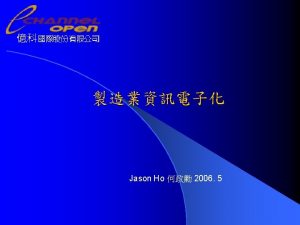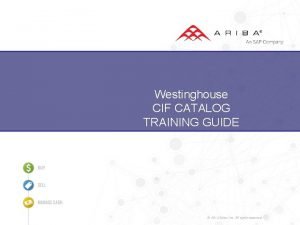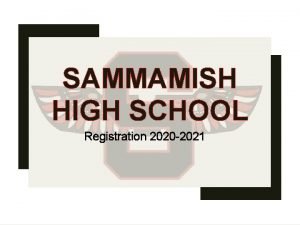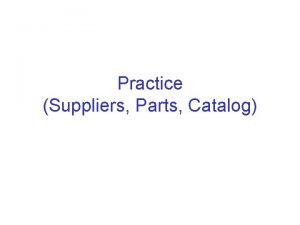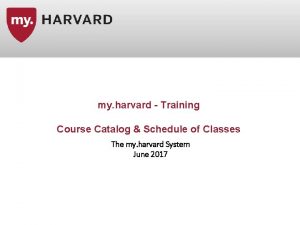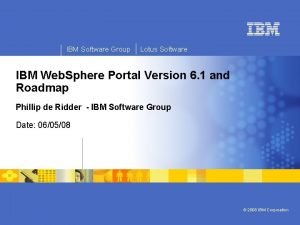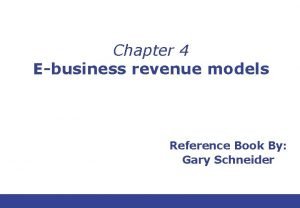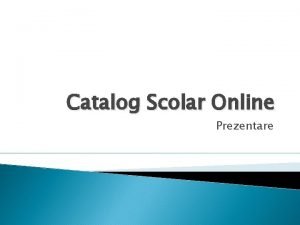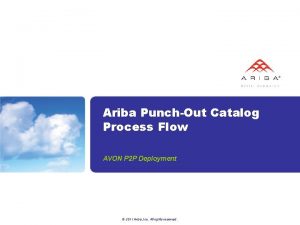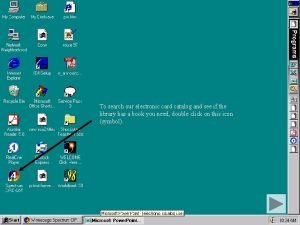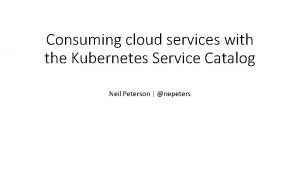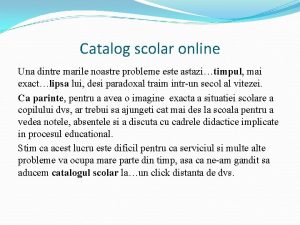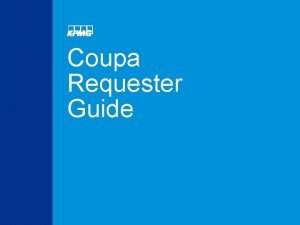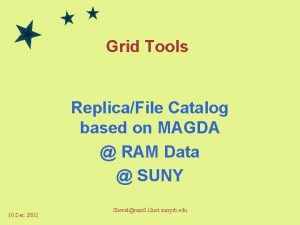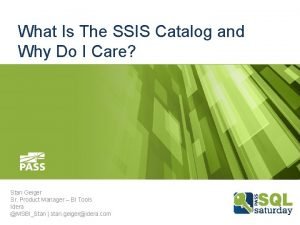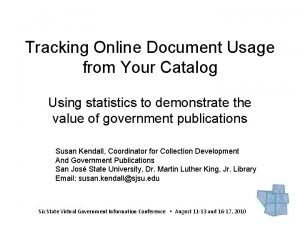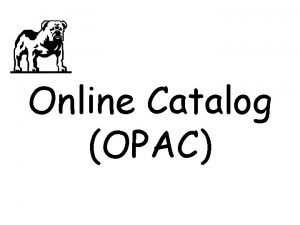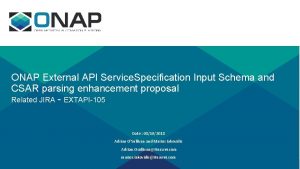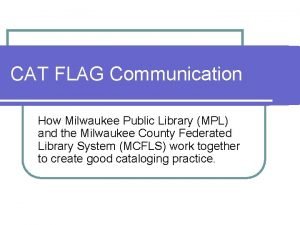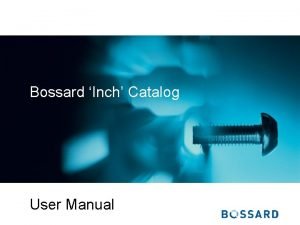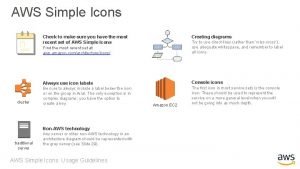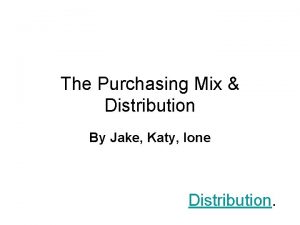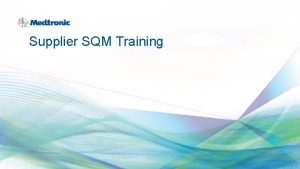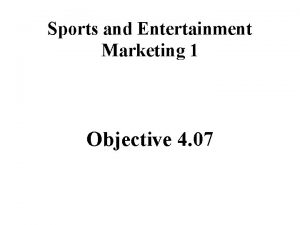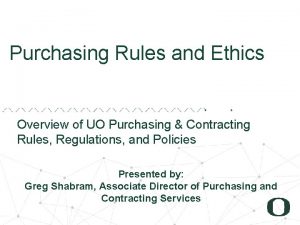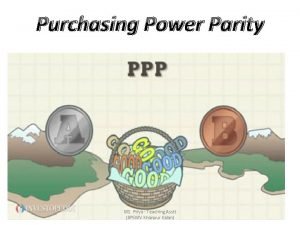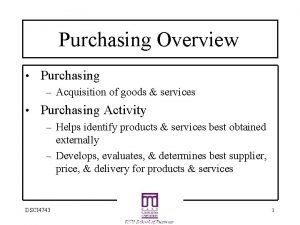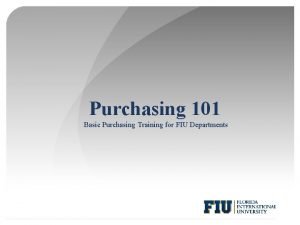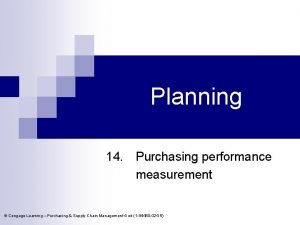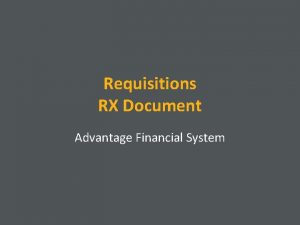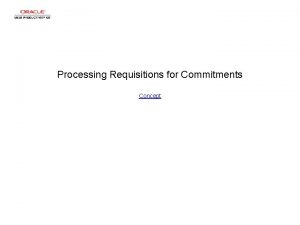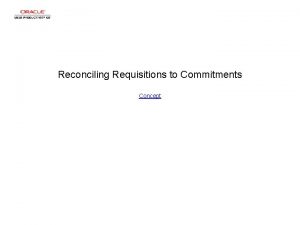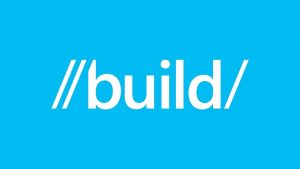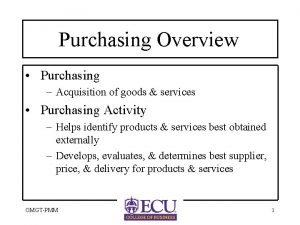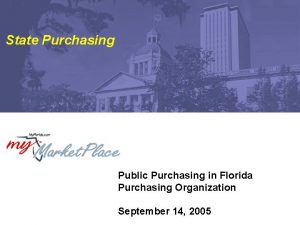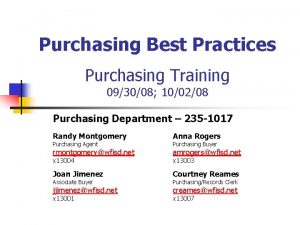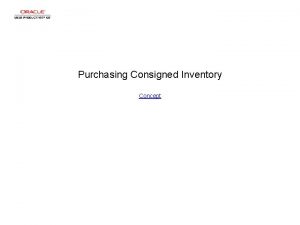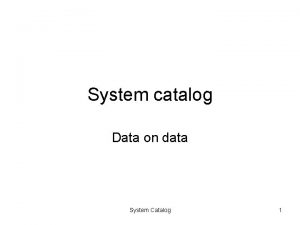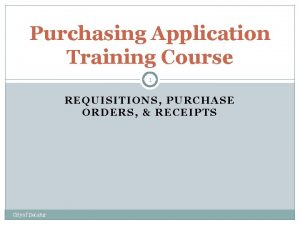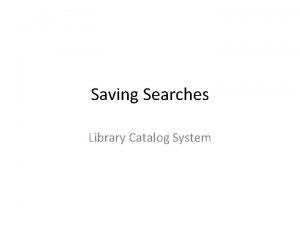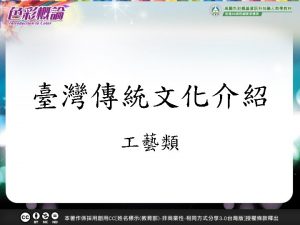KFS Purchasing System KFS Shop Catalog Requisitions noncatalog























































































- Slides: 87

KFS: Purchasing System

KFS Shop Catalog Requisitions (non-catalog requisitions follow)

Shop Catalogs is located in the Procurement & Accounts Payable section of the dashboard (click on that). User will then go into Shop Catalogs to begin the requisition. You could also use the “jump to…” and enter shop catalogs—it will take you to the same page.

User is able to click on the heart next to any selection to mark it as a favorite. The selection will appear on the main screen when the user logs into Kuali the next time.

After clicking on Shop Catalog, the user will be directed to the Shop Catalogs environment to shop and purchase supplies. When shopping is complete, the cart is returned to Kuali as a requisition and information is auto populated into the requisition. User is still required to input accounting information.

KFS Shop Catalogs Profile Setup

Click on your name and then click on “View My Profile”

Click on “Default User Settings” and then “Default Addresses”

Click on “Select Addresses for Profile”

Enter your 4 -digit campus delivery code in the “Nickname/Address Text” Box and then click “Search”

Click the radio button next to the correct address

Enter your building name, room number and department name in the appropriate boxes. To select this as your default address, click the box. Click “Save” upon completion.

The address will appear in the “Shipping Addresses” box. Follow these steps to create multiple shipping addresses for your profile.

KFS Shop Catalogs Hosted Catalog Searching (these catalogs don’t have a punch-out)

Users can do simple searches in the search field for hosted catalogs from the shop catalogs main screen. Enter your product to search and click go. Shop Catalogs will perform a search and return results based on keyword “beaker”. The result will include vendors, category, and manufacturer.

If part number is known, input the part number in the search engine. Click Go. The search result will filter to known part numbers from the hosted catalog vendors.

Once item has been found, click on “order from supplier”. User can Proceed to Checkout and complete shopping or continue shopping.

KFS Shop Catalogs Punch-out Catalogs

Punch-out Catalogs are listed on the Shop Catalogs Main page. User can click on the vendor logo to supplier website to shop. Once user clicks on the vendor logo…

User is placed within the supplier website to shop. User has same shopping experience as they would in a regular ecommerce site. User searches for product listed in the catalog.

Once item is found, user updates quantity and adds to cart. When shopping is complete click checkout. Cart is returned from supplier’s website. User may proceed to checkout or click on modify to change.

KFS Shop Catalogs Checkout Process/KFS Requisition

When completing the checkout process in Shop Catalogs, information stored as a default (shipping address) will auto populate and will allow user a chance to review their cart before submittal to KFS. User will click on Submit Cart to Kuali to populate requisition in KFS.

The KFS requisition will auto populate all of the required fields except accounting information. User will input account number, object code and percent and click add to save accounting information. Click “+” to save accounting information

Once accounting information has been saved, click on submit at bottom of page to forward requisition for account approval and additional approval workflow. Users can review route log to track what approvals are necessary before a purchase order is created and sent to vendor.

Non-Catalog Requisitions “No Quantity” and “Quantity” Requisitions

No Quantity Requisitions • • • “No Quantity” requisitions are used for open and service purchase orders Receiving is not required Multiple payments can be made

Click here to start the process of creating a requisition

Upon entering the requisition, a document and requisition number are created. Make note of the document number for searching later. This is a required field for all requisitions. For requisitions over $10, 000, the description will be changed to reflect the last name of the Purchasing Agent that is assigned the requisition.

The first time you create a requisition, you will need to set your default final delivery address. To do so, click on the magnifying glass next to Building.

This is the screen you will get after clicking on the magnifying glass.

Enter your building name using asterisk on both sides of the building name. In Kuali, less is more. For example, enter *Howes* instead of Howes Street Business Center and click “search. ”

Click “return value. ”

Enter your room number and click “set as default building. ”

You will not need to set your default address again. Please note, it is the receiving address that will dictate the location of delivery.

Search for a vendor by clicking on the magnifying glass.

For best results, use an asterisk before and after the vendor name. After inputting the vendor’s name, click “search. ”

Click “return value” to select your vendor.

If you do not see the address you need, click on the magnifying glass.

After clicking on the magnifying glass, this is what you will see if there are multiple addresses for a vendor. Click “return value” on the address you need. This should be the purchase order address versus the remit address.

This is the vendor with the correct address.

“No Quantity” requisitions are used for open and service purchase orders. Do not input anything in the quantity, UOM, catalog # or commodity code boxes.

Input a thorough description, the unit cost and click the “add” button. The description cannot be longer than 254 characters.

To add accounting at the line, click the “show” button.

Input your account number, object code, percent or dollar amount and click the “add” button. If you are using percentages, be sure they add up to 100.

To input additional accounting lines, use the top line and repeat the steps on the previous slide.

This is where you can add a quote or note for the vendor or Purchasing Agent. A note must be entered anytime an attachment is added to a requisition. To attach a file, click on “choose file” and go to the location of where the file is saved on your computer. If you want a note or quote to be sent to the vendor, select “yes” from the drop down menu. The note will accompany the attachment to the vendor.

To see the workflow approvals for your requisition, click the “arrow” button under the “route log” tab.

Click the “submit” button to start the workflow approval process for your document.

If your document was not successfully submitted, you will receive a red error message. The errors that need your attention will be marked in red at the location of the error (for example, if you have an accounting line error, a red error will appear in the “items” box). The errors will need to be corrected before you can resubmit.

Quantity Requisitions • • “Quantity” requisitions are to be used for goods only You must line out each item as it appears on your quote Receiving is required over $5000 Multiple payments can be made when partial shipments are received

Upon entering the requisition, a document and requisition number are created. Make note of the document number for searching later. This is a required field for all requisitions. For requisitions over $10, 000, the description will be changed to reflect the last name of the Purchasing Agent that is assigned the requisition.

The first time you create a requisition, you will need to set your default final delivery address. To do so, click on the magnifying glass next to “Building. ”

This is the screen you will get after clicking on the magnifying glass.

Enter your building name using an asterisk on both sides of the building name. In Kuali, less is more. For example, enter *Howes* instead of Howes Street Business Center and click “search. ”

Click “return value. ”

Enter your room number and click “set as default building. ” This only needs to be done once, regardless of whether the requisition is “quantity” or “no quantity”.

You will not need to set your default address again.

Search for a vendor by clicking on the magnifying glass.

For best results, use an asterisk before and after the vendor name. After inputting the vendor’s name, click “search. ”

Click “return value” to select your vendor.

If you do not see the address you need, click on the magnifying glass.

After clicking on the magnifying glass, this is what you will see if there are multiple addresses for a vendor. Click “return value” on the address you need. This should be the purchase order address versus the remit address.

This is the vendor with the correct address.

You must input a quantity, UOM, description, unit cost and then click “add. ” If you do not know the UOM, click on the magnifying glass in the UOM box to be able to search appropriate codes.

This is the screen you will see after you click on the magnifying glass in the UOM box.

Enter the unit of measure using an asterisk on both sides of the measurement and click “search. ” The search will populate values, click “return value” next to the correct unit of measure.

For header funding that will be applied to all lines of the requisition, click the “setup distribution” button. For funding at the line, click the “show” button next to “Accounting Lines. ” You will need to do this for each line of the requisition for line item funding.

After clicking “setup distribution, ” “Accounting Lines” will appear. Enter the account number, object code, percent or dollar amount and click “add. ” You can add multiple header accounting lines but the percent must be equal 100. Click “distribute to items” when you have added all of your header funding accounting lines.

This message will appear after clicking on “distribute to items. ” You will not get this message with funding at the line.

This is where you can add a quote or note for the vendor or Purchasing Agent. A note must be entered anytime an attachment is added to a requisition. To attach a file, click on “choose file” and go to the location of where the file is saved on your computer. If you want a note or quote to be sent to the vendor, select “yes” from the drop down menu (do not send internal notes). You should only send quotes for under $10, 000 to the vendor. If the requisition is routing to Procurement (over $10, 000), do not select yes to send to the vendor. The purchasing agent will do this step. The note will accompany the attachment to the vendor.

To see the workflow approvals for your requisition, click the “open” button on the “Route Log” tab.

Click the “submit” button to start the workflow approval process for your document.

If your document was not successfully submitted, you will receive a red error message. The errors that need your attention will be marked in red at the location of the error (for example if you have an accounting line error, a red error message will appear in the “items” box. The errors will need to be corrected before you can resubmit.

Importing Quotes – Requisitions Quote must be a CSV file.

CSV Import Parameters Note: 1. Be sure CSV file is setup in the format above. 2. Leave the “Commodity Code” column blank in your CSV file. 3. Do not use dollar sign in “Unit Cost” field. 4. Remove row with descriptors (i. e. , Quantity, UOM, Catalog #, etc. ) before uploading

Complete the “Document overview, ” “Delivery, ” and “Vendor “ tabs like any other requisition. To import your quote, click “import lines. ”

Click “choose file, ” locate the document on your computer , and then click “add. ” This will import your itemized quote into the requisition.

Fiscal Year Requisitions

Between April and June, Initiators need to select the appropriate fiscal year from a drop down box here. Otherwise, the fiscal year will default to the current one. Follow the steps for either a “no quantity” or “quantity” requisition.

Data Entry Fields to Avoid in the Requisition

Do not include information in the “Delivery Instructions” field as this information will not appear on the face of the Purchase Order for a vendor to view. Any instructions to a vendor should be included in the “Notes and Attachments” area towards the bottom of the Requisition.

Including information in the “Additional Suggested Vendor Names” will cause the requisition to enter an error queue or route to Procurement when it normally wouldn’t.

Selecting the “Restricted” field will cause the requisition to enter an error queue because the information will be invisible.

Using the “PO Total Cannot Exceed” field will cause the requisition to enter an error queue in Procurement.

Document Approval Limits Department Approvals <=$1000 Fiscal Officer Department (Doc. Types: AV, BA, DI, GEC, Encumbrance, TF) $100. 01 -$9999. 99 Fiscal Officer Department (organizations-ORG) (Doc. Type: DV, IB, IO, REQ, WOA) >=$10, 000 Fiscal Officer Department (organizations-ORG) Dean/VP Your PR may require additional approvals (i. e. , Separation of Duties, Animal Purchase Review, Property, etc. ) before it routes to Procurement.

For assistance: Lynette Brink 491 -5105 Procurement_Help_Desk@colostate. edu
 Purchasing images
Purchasing images Purchasing department structure
Purchasing department structure The demand planning function initiates requisitions for
The demand planning function initiates requisitions for Layout flow shop
Layout flow shop Umd accounting
Umd accounting Umd kfs
Umd kfs Uh ors
Uh ors Purchasing system
Purchasing system Dwp dynamic purchasing system
Dwp dynamic purchasing system Shop floor information system
Shop floor information system Using personal safety in agricultural mechanics
Using personal safety in agricultural mechanics Flow shop flexible
Flow shop flexible Cif ariba
Cif ariba Interlake course catalog
Interlake course catalog Tulang liriko kahulugan
Tulang liriko kahulugan Netflix rest api
Netflix rest api Texas health steps check up
Texas health steps check up Sammamish high school course catalog
Sammamish high school course catalog Find the names of suppliers who supply every part
Find the names of suppliers who supply every part Online public access catalogue
Online public access catalogue Ocls catalog
Ocls catalog Harvard extension course catalog
Harvard extension course catalog Ist telecom
Ist telecom Ibm software access catalog
Ibm software access catalog Open text catalogue
Open text catalogue Apache data catalog
Apache data catalog Contra costa county library
Contra costa county library Web catalog revenue model
Web catalog revenue model Catalog online scolar
Catalog online scolar Azure data catalog example
Azure data catalog example Ariba punchout catalog
Ariba punchout catalog Uh course catalog
Uh course catalog Electronic card catalog
Electronic card catalog Query course ntust
Query course ntust New york state industries for the disabled
New york state industries for the disabled Los angeles harbor college nursing
Los angeles harbor college nursing Interlake high school gifted program
Interlake high school gifted program Garland library catalog
Garland library catalog Klein oak course catalog
Klein oak course catalog Courseleaf api
Courseleaf api Catalog poem generator
Catalog poem generator Edu 24 autentificare
Edu 24 autentificare Keystone national highschool
Keystone national highschool Whats a free verse poem
Whats a free verse poem Minnesota common course catalog
Minnesota common course catalog Lau library catalog
Lau library catalog Gonzaga high school course selection
Gonzaga high school course selection Cmul opac
Cmul opac Ucf kinesiology masters
Ucf kinesiology masters Zilis compensation plan
Zilis compensation plan Catalog enrichment
Catalog enrichment Eku library database
Eku library database Catalog cet extension
Catalog cet extension What does pending buyer action mean in coupa
What does pending buyer action mean in coupa Unl interlibrary loan
Unl interlibrary loan Organization/actor catalog
Organization/actor catalog Ponte vedra high school course catalog
Ponte vedra high school course catalog Magda data catalog
Magda data catalog Ssisdb
Ssisdb Bellevue high school graduation requirements
Bellevue high school graduation requirements Pdis credential levels
Pdis credential levels Sjlibrary catalog
Sjlibrary catalog Catalog scolar word
Catalog scolar word Tmf service catalog
Tmf service catalog Mtda course catalog
Mtda course catalog Mixed bags designs catalog
Mixed bags designs catalog Imcpl catalog
Imcpl catalog Curriculum and catalog management
Curriculum and catalog management Unc charlotte course catalog
Unc charlotte course catalog A catalog sales company promises to deliver
A catalog sales company promises to deliver Advertising subscription mixed revenue model
Advertising subscription mixed revenue model County cat milwaukee
County cat milwaukee Bossard fasteners catalogue pdf
Bossard fasteners catalogue pdf Aws simple icons
Aws simple icons Ability one source
Ability one source Purchasing power parity formula
Purchasing power parity formula What are the purchasing mix
What are the purchasing mix Medtronic supplier change portal
Medtronic supplier change portal Nerolac paint price 20 litre
Nerolac paint price 20 litre Which is a tangible benefit of purchasing a surfboard?
Which is a tangible benefit of purchasing a surfboard? Uo purchasing and contracting
Uo purchasing and contracting Purchasing power parity theory
Purchasing power parity theory Invoiceless purchasing
Invoiceless purchasing Fiu procurement
Fiu procurement Evaluating purchasing performance
Evaluating purchasing performance Absolute purchasing power parity
Absolute purchasing power parity Law of one price and purchasing power parity
Law of one price and purchasing power parity Ppp theory of exchange rate
Ppp theory of exchange rate

